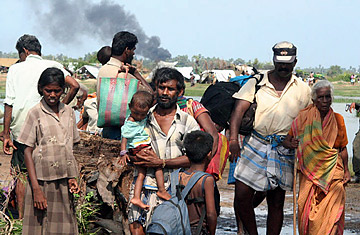
The Sri Lankan army says thousands of people fleeing an area held by the Tamil Tiger separatists in northeastern Sri Lanka.
Sri Lankan military authorities predicted a swift end to the country's 25-year civil war after tens of thousands of civilians who had been trapped in a narrow combat zone in the country's north for over two months escaped the iron grip of the Liberation Tigers of Tamil Eelam (LTTE) on April 20. But more fighting is in store before that end can be reached. It will take weeks, if not longer, to capture or kill the over 500 hardcore Tigers — including leader Velupillai Prabhakaran, who is holed up deep inside the zone — ready to fight to the death. (Read a 2-minute biography on Tamil Tiger Leader Velupillai Prabhakaran.)
The Tigers had built an earth bund, several meters high, around a narrow 12-km (7.5-mile) no-fire zone on the eastern shores of the Mulaithivu lagoon and, according to reports from the area, had set up gun encampments every 30 meters (98 feet) or so along it. According to Laxman Hulugalle, Director General of the Sri Lankan defense ministry's Media Centre for National Security, after overnight fighting, troops captured a small stretch of the fortified earth bund on the morning of April 20, and between 25,000 and 30,000 civilians trapped behind the bund streamed through. (See pictures of Sri Lanka: Tiger Territory.)
As the army moves in and civilians move out of the zone, close-quarter fighting is all but a certainty. But there is likely to be heavy resistance from the Tigers who would literally be fighting a battle for survival. "This is the end of the Tamil Tigers," Hulugalle tells TIME. "They held these civilians by force for so long, but they cannot do that any longer." Just two years ago, the Tigers held vast swaths of land in the country's north, but have now been limited to a 20 sq km (7.7 sq mi) coastal zone surrounded by the military. A naval blockade to the east has also cut off possible escape routes. On Monday, the Sri Lankan government gave the Tigers 24 hours to surrender.
Many thousands of civilians have been forced to flee since fighting started in March 2008, when the Sri Lankan army began advancing on areas held by the Tigers in the northern region known as the Vanni. Over 65,000 civilians have since braved the fighting and escaped to safety behind army lines, and another 10,000 sick and wounded civilians and caregivers have been evacuated by sea by the International Committee of the Red Cross.
The civilians who escaped on Monday were among over 150,000 trapped in the now narrow battle zone, according to the U.N.; the Sri Lankan government puts the figure at around 70,000. "We cannot give an exact figure, it is very difficult," Hulugalle says. The U.N. has warned that conditions are precarious within the zone, with civilians running short on safe drinking water and food, and getting caught in the crossfire.
There was no confirmation from the Tigers on the latest exodus, but the pro-Tiger TamilNet website reported that government troops had entered the no-fire zone on Monday morning. "Full firepower is being deployed by the [Sri Lankan army]," the site said. "Multi-Barrel Rocket Launcher fire, shelling, RPG fire and gunfire have hit several places causing heavy civilian casualties." The Sri Lankan military said that Tigers used a battle tank to fire at the troops and escaping civilians; footage of the firing obtained by an unmanned aerial vehicle (UAV) was later released by the airforce. According to the Defense Ministry, Tigers also carried out three suicide attacks as the civilians began to flee across the frontline. Army sources in the capital Colombo add that the attacks killed 17 civilians — including several children — and injured 200. (Read a brief history of the Tamil Tigers.)
Later in the day on Monday, the Tigers released a statement calling for an unconditional cease-fire and negotiations: "The LTTE would like to reiterate its commitment to a cease-fire without any preconditions, as urged by the U.S. and other members of the international community. The LTTE is also ready for a meaningful negotiation on all issues related to humanitarian access, security, movement and welfare of the Tamil civilian population." The Tigers have been calling for a cease-fire since the beginning of the year, but the government has refused to agree to a truce, alleging that the separatist fighters would use the respite to regroup and rearm.
President Mahinda Rajapakse did declare a two-day suspension of offensive operations between April 13 and 14, to coincide with the traditional New Year holiday. During the truce, only about 700 civilians managed to escape the fighting. The latest bout of heavy fighting commenced soon after, with the government rejecting calls by the U.N. and several western countries — including the U.S. — to extend the truce. "The process of the complete defeat of the LTTE has just begun," President Rajapakse told AFP news agency on Monday morning, as he watched footage of the exodus obtained by UAVs showing long lines of civilians crossing over to army-held areas. "It is now all over for the Tigers." The Defense Ministry later termed the latest flood of civilian escapees "the world's largest hostage rescue mission."
The coming days are likely to see more civilians trying to escape the fighting as the military intensifies its advances to corner the Tigers, who are now left with only two options — surrender or die fighting.
See pictures of areas previously controlled by the Tamil Tigers.
